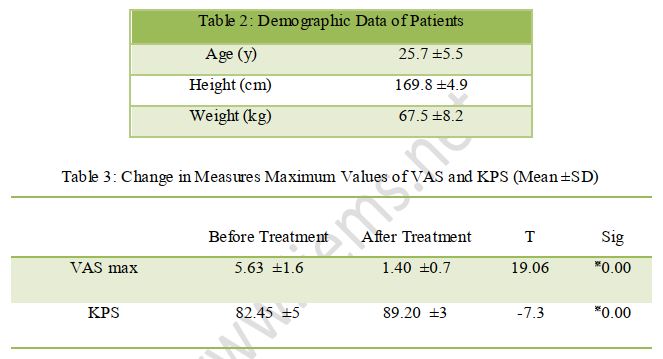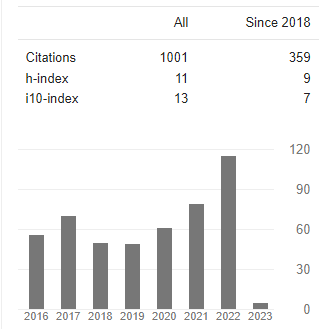THE EFFECT OF 8 WEEKS PILATES TRAINING ON THE TREATMENT OF PATELLOFEMORAL PAIN SYNDROME
Abstract
The purpose of this research was to determine the effect of 8 weeks Pilates training on the treatment of Patellofemoral Pain syndrome (PFPS). This study is single grouped experimental pre-post test design. Subjects were 20 male with bilateral PFPS, (25.7 ±5. 5 years old). Subjects accomplished Pilates training program for 8 weeks, 3 days a week. Paired sample T-test was used to analyze the data of the study by use of SPSS software. The result showed that 8 weeks Pilates training significantly improved PFPS, therefore knee function and knee pain has improved and decreased respectively following the treatment. It is concluded that 8 weeks Pilates training could improve PFPS. Therefore, the Pilates method behaved as a useful therapeutic tool in the increase of subject’s knee function. It is hence an important alternative in the prevention as well as recovery of patellofemoral pain syndrome and related injuries triggered by the decrease of the muscular length, abnormal lower limb biomechanics, soft-tissue tightness, muscle weakness, neuromuscular imbalance between muscles and excessive exercise.
Downloads
References
[2] Baquie P, Brukner P: Injuries presenting to an Australian sports medicine centre: A 12-month study. Clin J Sport Med 1997; 7:28–31.
[3] Bennell K, Bartram S, Crossley K, Green S. Outcome measures in patellofemoral pain syndrome: test-retest reliability and interrelationships. Phys Ther Sport 2000; 1:32-41.
[4] Bily W, MD, Trimmel L, MD, Mödlin M, MD, Kaider A, MSc, Kern H, MD. Training Program and Additional Electric Muscle Stimulation for Patellofemoral Pain Syndrome. American academy of physical medicine and rehabilitation. 2008:89:7.
[5] Boling MC, Bolgla LA, Mattacola CG, Uhl TL, Hosey RG. Outcomes of a weight-bearing program for patients diagnosed with patellofemoral pain syndrome. Arch Phys Med Rehabil 2006; 87:1428-35.
[6] Callaghan MJ, Oldham JA. The role of quadriceps exercise in the treatment of patellofemoral pain syndrome. Sports Med 1996; 21: 384-91.
[7] Chesworth BM, Culham EG, Tata GE, Peat M. Validation of outcome measures in patients with patellofemoral syndrome. J Orthop Sports Phys Ther 1989; 10:302-8.
[8] Clark DI, Downing N, Mitchell J, Coulson L, Syzpryt EP, Doherty M. Physiotherapy for anterior knee pain: a randomised controlled trial. Ann Rheum Dis 2000; 59:700-4.
[9] Cowan SM, Bennel KL, Hodges PW. Therapeutic patellar taping changes the timing of vasti muscle activation in people with patellofemoral pain syndrome. Clin J Sport Med. 2002;12(6):339-47.
[10]36 Crossley K, Bennell K, Cowan S, Green S. Analysis of outcome measures for persons with patellofemoral pain: which are reliable and valid? Arch Phys Med Rehabil 2004; 85: 815-22.
[11] Crossley K, Bennell K, Green S, Cowan S, McConnell J. Physical therapy for patellofemoral pain. A randomized, double blinded, placebo-controlled trial. Am J Sports Med 2002; 30:857-65.
[12] De Haven K, Dolan W, Mayer P. Chondromalacia in athletes. Am J Sports Med 1979; 7:5– 11.
[13] Devereaux M, Lachmann S: Patello-femoral arthralgia in athletes attending a Sports Injury Clinic. Br J Sports Med 1984; 18:18–21.
[14] Green ST. Patellofemoral syndrome. J Bodyw Mov Ther. 2005;9:16-26.
[15] Holmes SW, Clancy WG. Clinical classification of patellofemoral pain and dysfunction. J Orthop Sports Phys Ther 1998; 28:299– 306.
[16] Jago R, Jonker ML, Missaghian M, Baranowski T. Effect of 4 weeks of Pilates on the body composition of young girls. Prev Med. 2006;42(3):177-80.
[17] Kannus P, Natri A, Nittymaki S, Jarvinen M. Effect of intraarticular glycosaminoglycan polysulfate treatment on patellofemoral pain syndrome. Arthritis Rheum 1992; 35:1052-61.
[18] Kujala UM, Jaakola LH, Koskinen SK, Taimela S, Hurme M, Nelimarkka O. Scoring of patellofemoral disorders. Arthroscopy 1993; 9:159-63.
[19] Levine B, Kaplanek B, Scafura D, Jaffe WL. Rehabilitation after Total Hip and Knee Arthroplasty. A New Regimen Using Pilates Training. Bulletin of the NYU Hospital for Joint Diseases 2007; 65,2:120-125.
[20] Mascal CL, Landel R, Powers C. Management of patellofemoral pain targeting hip, pelvis, and trunk muscle function: 2 case reports. J Orthop Sports Phys Ther. 2003; 33(11):647- 660.
[21] Piva SR, Goodnite EA, Childs JD. Strength around the hip and flexibility of soft tissues in individuals with and without patellofemoral pain syndrome. J Orthop Sports Phys Ther. 2005; 35(12):793-801.
[22] Powers CM. Rehabilitation of patellofemoral joint disorders: a critical review. J Orthop Sports Phys Ther 1998;28:345-54.
[23] Roostayi MM, Bagheri H, Moghaddam ST, Firooznia K, Razi M, Hosseini M, et al. The effects of vacuumic bracing system on the patellofemoral articulation in patients with patellofemoral pain syndrome. Complement Ther Clin Pract. 2009;15(1):29-34.
[24] Santiago M. Physio pilates. Disponível em: http://www.physiopilates.com. Acesso em: 21 junho 2006.
[25] Shelton GL, Thigpen LK. Rehabilitation of patellofemoral dysfunction: a review of the literature. J Orthop Sports Phys Ther 1991; 14:243–249.
[26] Tang SF, Chen CK, Hsu R, Chou SW, Hong WH, Lew HL. Vastus medialis obliquus and vastus lateralis activity in open and closed kinetic chain exercises in patients with patellofemoral pain syndrome: an electromyographic study. Arch Phys Med Rehabil. 2001;82(10):1441-5.
[27] Thomeé R. A comprehensive treatment approach for patellofemoral pain syndrome in young women. Phys Ther 1997; 77:1690-703.
[28] Thomeé R, Augustsson J, Karlsson J. Patellofemoral pain syndrome: a review of current issues. Sports Med 1999; 28:245-62.
[29] Tyler TF, Nicholas SJ, Mullaney MJ, McHugh MP. The role of hip muscle function in the treatment of patellofemoral pain syndrome. Am J Sports Med. 2006; 34(4):630-636.
[30] Ungaro A. Pilates Body in Motion. NewYork: DK Publishing, 2002.
[31] Vengust R, Strojnik V, Pavlovcic V, Antolic V, Zupanc O. The effect of electrostimulation and high load exercises in patients with patellofemoral joint dysfunction. A preliminary report. Pflugers Arch 2001; 442(Suppl 1):R153-4.
[32] White L, Dolphin P, Dixon J. Hamstring length in patellofemoral pain syndrome. Physiotherapy. 2009; 95(1):24-28.
[33] Wilk KE, Davies GJ, Mangine RE, et al: Patellofemoral disorders: A classification system and clinical guidelines for nonoperative rehabilitation. J Orthop Sports Phys Ther 1998; 28:307–22.
[34] Wise H, Fiebert I, Kates J. EMG biofeedback as treatment of patellofemoral pain syndrome. J Orthop Sports Phys Ther 1984; 6:95–103.
[35] Witvrouw E, Lysens R, Bellemans J, Cambier D, Vanderstraeten G. Intrinsic risk factors for the development of anterior knee pain in an athletic population: a two-year prospective study. Am J Sports Med. 2000; 28(4):480-489.















